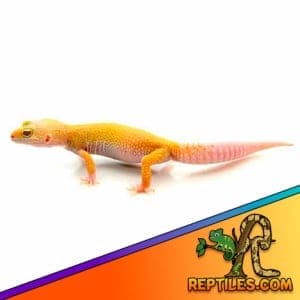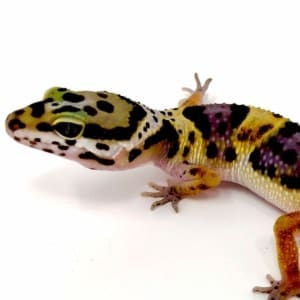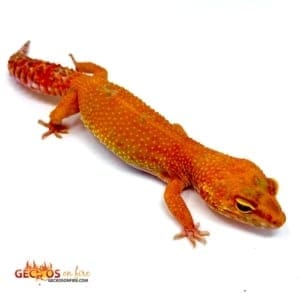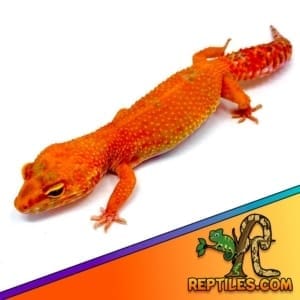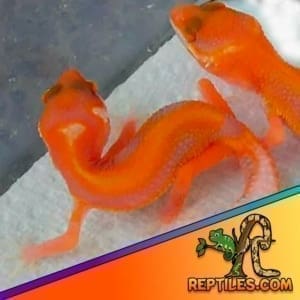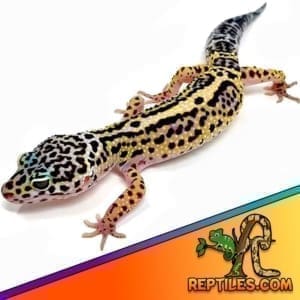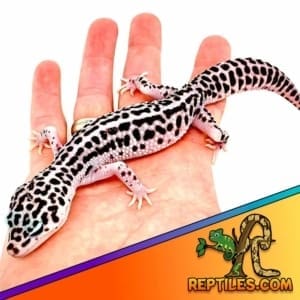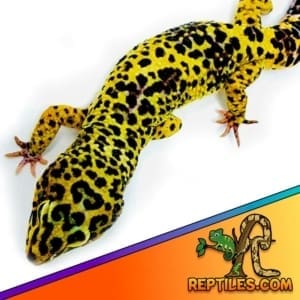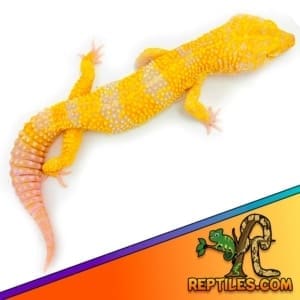Leopard gecko care sheet
5 things to know about your leopard gecko
- Leopard geckos live as long as 20 years
- Did you know that the leopard gecko is one of only a few gecko species that has distinct outer ears and actual eyelids?
- baby leopard geckos will grow as long as 10 inches with supergiants reaching over 100 grams!
- In the wild, leopard geckos live in the desert and within rock formations, hiding most of the day, since they are nocturnal
- Unlike other pet geckos for sale, the leopard gecko doesn’t have sticky hands, so they are not able to climb up the sides of walls and tall terrarium glass like many other geckos including crested geckos for sale, and gargoyle geckos for sale.
How do I set up my leopard gecko’s home?
Leopard geckos for sale originate from the desert, so naturally, they love a warm, dry environment. But they also need a hiding place that’s moist and lovely—this is where they retreat to when it’s time to shed their skin. Up to three leopard geckos can live in the same terrarium—but only one should be male. Leopard geckos are amongst the most popular geckos for sale anywhere.
Leopard gecko terrarium
You’ll want to keep your leopard gecko in a well-ventilated terrarium with a screened lid. Start with a ten-gallon tank. If you’re getting three geckos, think about increasing your tank size.
Leopard gecko Lighting
Leopard geckos do not require UVB like some reptiles, therefore, lighting is an option. Some Geckos require 12 hours of visible light a day, but NOT leopards. If you want to see what they do under cover of darkness, pick up a night-specific bulb. Then you can see what your reptile pals are up to without disorienting them with a bright light at night.
Leopard gecko Temperature and humidity
Keep your leopard gecko’s habitat toasty, like the warm climate he comes from. You should have a warm side and a cool side of the tank, and let him decide the area he likes best. To do this, put a heat light on one side of the habitat, and measure the temperature with a thermometer at each end.
You’re aiming to keep the terrarium between 85 and 95 degrees F (29 to 35 C) on the warm end, and ten degrees lower on the cool side. It’s also worth getting a hygrometer, to make sure humidity remains in that 10% to 30% range, which geckos prefer.
Shop thermometers & hygrometers
How do I set up my pet leopard gecko’s habitat?
Use a layer of calcium sand (substrate) 2 to 3 inches deep (5 to 8 cm) or reptile carpet. For geckos shorter than 6 inches (15 cm), use reptile carpet—these guys are so small they might accidentally swallow the sand, which is bad for them. Scoop the waste at least once a week, and change all their bedding at least once a month. Keeping your pet leopard gecko for sale healthy revolves around proper habitat cleanliness and a regular maintenance cleaning schedule.
Lizards like to play hide and seek, so your baby leopard geckos will thank you for placing a rock, branch or other hiding places on the cool side of the habitat. One hiding spot per gecko is a good rule. Use rocks and branches to make your reptile friends a desert playpen. Putting some moistened moss in their hide house will help when they’re ready to shed their skin. Mist the moss periodically with a spray bottle of water to keep the humidity higher inside their hide house.
Leopard Gecko Diet
Leopard geckos are almost always primarily fed mealworms. We offer mealworms for sale online as well. Also, crickets may also be fed, typically they are dusted with a calcium with vitamin d3 combination. Crickets may also be gut loaded by feeding them a high quality variety of greens.
Leopard gecko supplements
We use a combination of Reptical Reptile Calcium with Vitamin D3 mixed 50/50 ratio with Reptivite, or Vionate as a vitamin and mineral supplement.
Leopard Gecko Water
Some say that leopard geckos consume enough hydration thru the insects in which they eat. We here at Gecko Fire provide all of our reptiles for sale including our leopard geckos filtered water. Fresh filtered water should be provided at all times to ensure proper hydration.
Leopard gecko Humidity
While humidity is semi-important, most of that can be handled by simply supplying humid hides. Humid hides are also used for nesting and are most beneficial for shedding. Provide both a warm humid hide as well as a cool humid hide. We normally place a heat pad on the underside of the terrarium or aquarium setup underneath the one hide. The other side is usually kept cool by providing a hide that is in the cooler end of the habitat. Shedding is often done within the hides and the leopard geckos often eat their own skin. In nature, they do this to avoid predators finding them.
Leopard gecko habitat setup part 2
Unless you are considering breeding leopard geckos or being a leopard gecko breeder, we recommend 1 male or multiple females. Up to 4 females can be housed together in a simple 20-gallon tank, or aquarium. We use paper towels as a substrate as they are most sanitary and cheapest. Reptile carpet is often used to add color to the setup. Try to stay away from using loose substrate, like sand, or gravel as it could lead to impaction based complications.
Leopard gecko Substrate
The substrate can be as simple as a paper towel, or reptile carpet. The main thing to consider is NOT to use anything that can cause impaction. If your leopard gecko has loose stool, sand or gravel is extremely risky. It may also be accidentally ingested during feeding, which also can cause complications or death.
Leopard Gecko Morphs
More common leopard gecko morphs including mack snow leopard gecko, tangerine leopard gecko, and blizzard leopard geckos for sale. The rarer the color morph, the higher the price is typically what you’d expect. Here at Gecko Fire, we offer everything under the sun when considering leopard gecko color morphs for sale. If you are looking for something super rare, check out the black night leopard gecko selection. Want rare color? Check out a supergiant blood leopard gecko.
Top Leopard Gecko color morphs for sale
There are so many to choose from and with a real biologist on site, leopard gecko genetics are something we really are passionate about! Leopard geckos are available as babies, juveniles, and young adults. Selecting your favorite color morph is a tough choice, so consider purchasing females so multiple geckos can be housed together.
keeping your leopard gecko healthy is easy
It’s a good idea to have a veterinarian examine your leopard geckos if you notice any symptoms or acting lethargic during both day and nighttime. When your baby leopard geckos arrive home, try not to handle them for four to five days. This will enable them to settle in and get used to their new home, temperatures, and surroundings. Keeping a close eye on them is key, in case they are stressed. We recommend checking with your local reptile vet if your leopard gecko has any of these symptoms.
- Discharge from the eyes or mouth
- Discolored skin or shedding problems where the shed is not coming loose. For this reason, be sure to provide a humid hide so they can shed correctly.
- Eating or drinking less; even losing weight
- Droppings that are runny for more than two days





